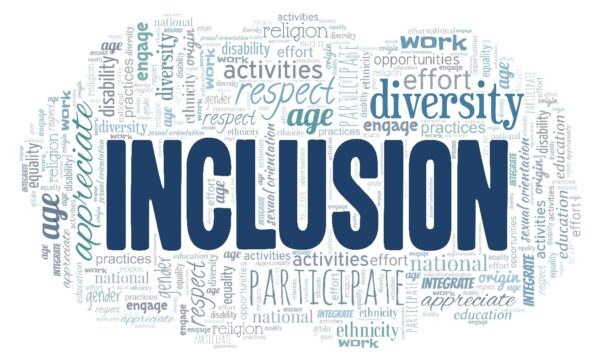Essentially, using inclusive language means being conscious of the language you choose so as not to exclude anyone from the conversation. Being purposeful about using inclusive language in your content marketing shows your audience you’re aware of issues that affect them in their day to day lives and that you’re willing to grow and change as your awareness increases. As Workhuman put in their article, “Using inclusive language communicates with people in a way that is respectful and brings everyone into the conversation.”
Connecting with your target audience on a personal level should be one of the primary goals of content marketing. Inclusive language builds a sense of trust with consumers, which in turn will lead them back to your brand time and time again.
In this article, we will highlight seven areas to look at critically when editing your content marketing for the use of inclusive language.
Gender-Neutral Language
One of the first things to look for when you’re reviewing your content marketing is gender-neutral terms. Specific things to look for when editing in the area of gender are:
- The use of partner, sibling, student or child in place of more gender-specific terms.
- Gender-neutral forms of occupations and words. For example, “firefighter” instead of “fireman” and “humanity” instead of “mankind.”
- When appropriate, the use of “they” instead of “he” or “she.”
As Grammarly states, “Using gender-neutral language is an important habit because it demonstrates respect for people of all backgrounds, genders, and beliefs, and it includes everyone in the conversation. This is an especially helpful way to show support for members of LGBTQIA+ communities.”
Even if you are not speaking to the LGBTQIA+ community, gendered language divides up audiences and can be clunky. Using gender-neutral language in your content marketing will go a long way to making sure that your work is as inclusive as possible.
Ethnicity, Race And Nationality
As with all forms of language, what might be inclusive now may not be accepted five to ten years from now. As noted by the APA, “Terms used to refer to racial and ethnic groups continue to change over time. One reason for this is simply personal preference; preferred designations are as varied as the people they name. Another reason is that designations can become dated over time and may hold negative connotations.”
Things to look for when examining mentions of ethnicity, race and nationality for inclusive language are:
- Determining whether racial and/or ethnic terms mentioned are what the particular group uses themselves.
- Ascertaining whether a specific term is one that should only be used by members within the community.
- Ensuring stereotypes are not perpetuated. For example, the assumption is not made that all members of an underrepresented group are underprivileged.
- Checking that race is referred to only when relevant to the context.
Disability, Health And Neurodiversity
When reviewing content marketing that refers to disability, health or neurodiversity, it is essential to put the human first. While there is some debate in the community, here are some general guidelines:
- Person-first language should be used over identity-first language (for example, “a child with Down syndrome” as opposed to “a Down syndrome child”).
- A disability or condition is only mentioned when it is relevant.
- Terminology that suggests that a person “suffers” from their disability should be avoided.
- Neutral language is preferred, such as “does not have a disability” instead of “able-bodied.”
As always, remember what some people are comfortable with others may not prefer. Flexibility is crucial to creating a safe environment with your words.
Age
When content marketing mentions age, there are a few guidelines to make sure that the reference is as inclusive and respectful as possible. Generally speaking, the APA handbook advises that:
- Terms such as seniors and elderly should no longer be used. Instead, use such terms like older adult, or be specific about which age range you’re referring to (such as “someone between the ages of 65-75”).
- Negative attitudes about aging should be avoided.
- Language that conveys aging as a normal part of the life experience is preferred.
Using inclusive language in your content marketing extends beyond being careful of the words you use regarding older adults. Young people deserve respect and inclusion as well. For language to be truly inclusive, it must create space for everyone.
Socioeconomic Status
Socioeconomic status (SES) is more than income. It also includes education, professional opportunities and subjective perceptions of social status and class. As such, it’s important that you take care when creating content and referring to someone’s SES. Some things to consider when editing content marketing for inclusive language include:
- Person-first language should be used. For example, instead of saying “a homeless person” use “a person who is homeless.”
- Be careful to avoid language that blames people for their circumstances. An example of this would be to say, “a person without a high school diploma” over “a high school dropout.”
- Words such as “ghetto,” “the projects” or “inner city” can be associated with negative connotations. Specific details about where something is located would be preferred.
As you may have noticed, the goal here is similar to many of the other topics we’ve discussed. Put the human before the perceived problem. People deserve to retain their humanity regardless of their situation.
Plain Language
Since your primary goal in editing any content marketing is to make sure it is easy to read and understand, you will want to implement plain language. Businesses are tempted to use jargon and big words to prove they are experts in their industries. This, however, is othering and is off-putting for many customers.
Additionally, for many people who aren’t native English speakers, some words and phrases may be difficult to understand. So, it’s also critical to listen for turns of phrase that don’t translate well in other cultures.
Here are the qualities your marketing content should have:
- The words and references used should be understood by many people.
- Explanations for certain words and concepts should be provided to make the language as inclusive as possible.
- Words or phrases that someone who speaks limited English may not understand should be avoided.
This may seem difficult or unnecessary, especially in many technical lines of work, but if your content marketing is accessible to as many people as possible your audience will be able to grow too.
Images
Images can be immensely powerful in any type of content marketing. They are especially useful for conveying emotion and helping brands connect with their audience on a more personal level. This is especially true of imagery that portrays human faces.
Images may not be written language, but they should be examined just as critically. Your audience wants to be able to see themselves in your content marketing, both in the text and in the images they see. Things to look for when reviewing images for inclusivity are:
- Diverse groups of people in the imagery. This can include different races, genders, ages and abilities.
- Members of diverse groups completing tasks that they are traditionally underrepresented in. An example of this could be a woman of color shown in a leadership position.
The importance of having a diverse group of people in your content marketing imagery cannot be stressed enough. For someone to connect with your brand, they have to feel that your company sees and understands them. If a person can identify themselves immediately by looking at your social media, blog or website, you will already have taken a big step forward in earning their trust.
Conclusion
The ideas listed above are certainly not the only areas where you should edit for inclusive language in your content marketing, but they are a good place to start. While incorporating this type of language may seem like a hefty task, in practice it is fairly simple to employ.
You want your customers to see your brand as one that cares, one that is willing to stretch and listen. You may not be able to use (or even need to use) inclusive language in every area of your content marketing, and you may make mistakes, but consumers will see you trying. And that’s an important first step.
As Hubspot reminds us, “Remember — inclusive language is about widening your message and allowing it to resonate with as many people as possible, so it’s critical for your business’s bottom-line that you do everything you can to communicate more inclusively every day.
One more thing that’s important to note is that you’re not expected to know everything all the time. Guidance on using inclusive language changes frequently, and it can be difficult to keep up. All major style guides have sections on the correct usage of inclusive language in the areas that have been mentioned above. When editing your content marketing for inclusive language, consult style guides, dictionaries and most importantly, ask people within your audience for advice.
Are You Looking For A Content Marketing Partner?
If you are looking for help with your content marketing, contact Three Girls Media today. We have a team of successful and talented marketing specialists who are particularly adept at using inclusive language in their content marketing. We are ready to work with you and help grow your brand!
Special Offer:
Sign up for a complimentary consultation during January and receive an Email Marketing Guide valued at $475! We offer a 30-minute phone consultation with our CEO and can answer your questions and discuss your specific marketing needs – no strings attached. Call 360-955-1410 or contact us today to arrange your consultation!




